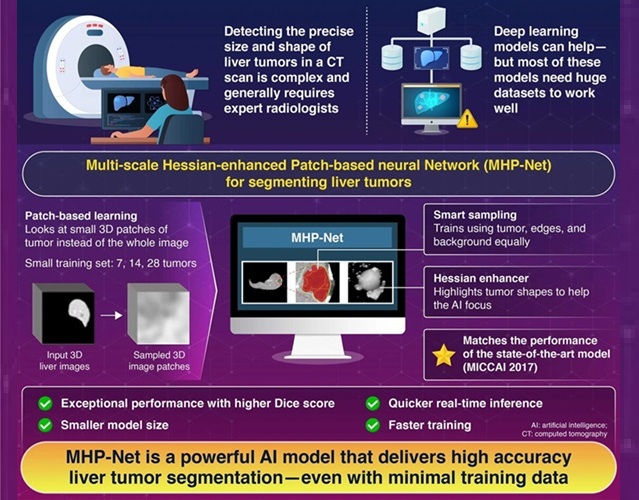Groundbreaking AI Model Accurately Segments Liver Tumors from CT Scans
Posted on 02 Sep 2025
Liver cancer is the sixth most common cancer worldwide and a leading cause of cancer-related deaths. Accurate segmentation of liver tumors is critical for diagnosis and therapy, but manual methods by radiologists are time-consuming and prone to variations in expertise. Artificial intelligence (AI)-based segmentation has advanced the field, yet most models require thousands of cases for training, creating a barrier to adoption. Now, a groundbreaking AI model has shown high accuracy even with limited training datasets.
Researchers at the Institute of Science Tokyo (Tokyo, Japan) have developed the Multi-scale Hessian-enhanced Patch-based Neural Network (MHP-Net), a deep learning model for liver tumor segmentation. Instead of analyzing entire scans at once, MHP-Net divides images into 3D patches and pairs them with enhanced versions using Hessian filtering, which highlights spherical features like tumors. This architecture creates precise segmentation maps from contrast-enhanced CT scans.

The model’s accuracy was evaluated using Dice similarity scores, which measure overlap between predicted and expert-annotated tumor boundaries. Despite training on datasets as small as 7, 14, and 28 tumors, MHP-Net achieved Dice scores of 0.691, 0.709, and 0.719, respectively. The findings, published in IEEE Access, show the model outperformed established AI systems such as U-Net, Res U-Net, and HDense-U-Net.
In addition to its accuracy, MHP-Net’s lightweight design allows training in under 10 minutes and real-time inference in about four seconds per patient, making it suitable for clinical use with limited computing power. By reducing data requirements, it opens AI adoption to under-resourced hospitals worldwide. Researchers plan to expand the model’s applications, exploring small-data AI solutions for rare cancers and broader medical imaging challenges.
“This is just a start in the field of small-data AI, where meaningful and clinically relevant deep learning models can be built from limited datasets,” said Professor Kenji Suzuki, who led the development of the model. “MHP-Net’s success can inspire small-data AI solutions in other areas of medical imaging as well, such as the detection of rare cancers.”
Related Links:
Institute of Science Tokyo










 Guided Devices.jpg)



